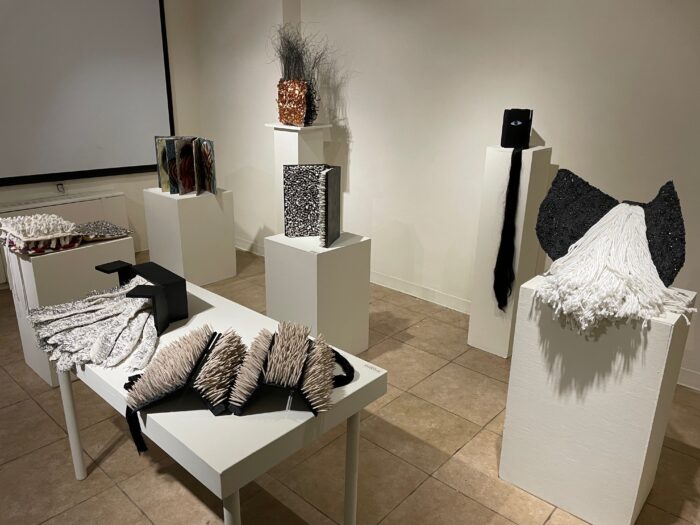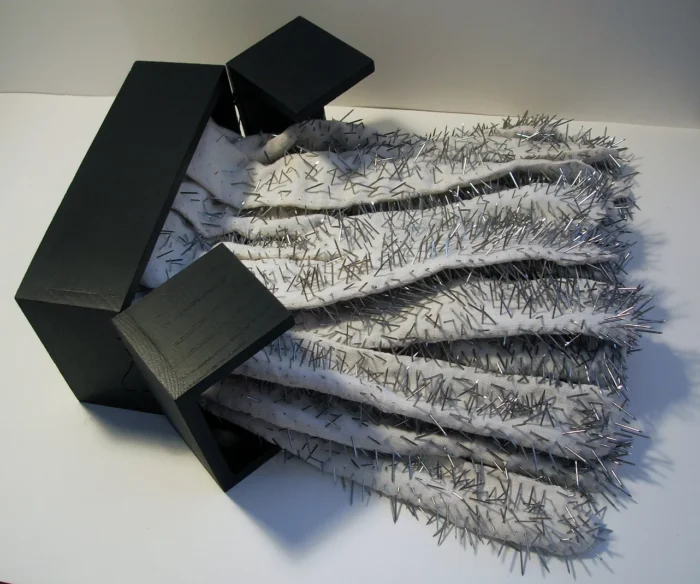
Despo Magoni, Heejung Kim, and Mark Bloch, the three artists included in this very strong show, mostly presented materials associated with artists’ books. In the comfortable gallery space run by Paris Koh, the book materials were presented both as physical objects and as vehicles for the display of two-dimensional art, mostly paintings on paper. The two women, Magoni and Kim, look to different expressions: Magoni tends to make black-and-white abstractions on paper. In one work, the small paintings are folded across a single horizontal plane. In contrast, Kim’s highly sculptural books are often platforms for smaller works art that are sculptures themselves. They are made so that the covers can be folded together–despite the often protruding shapes that fill the books’ interior. Indeed, in one book, there are teeth-like forms that extend upward some three inches, but when the outside covers of the book are folded, the two interiors mesh without jamming into each other.

In contrast, Bloch’s art is richly devoted to paintings on paper; they don’t describe a narrative so much as they are one-off visual statements. Bloch’s “illustrations” –I use quotation marks since the works are more art expressions than visuals tied to a text–in this case, nonexistent. The images fill the page and follow each other like a novel, but the emphasis is on visual import rather than literary meaning.
Bloch, a mid-career artist, presents here books whose images are unusually original. He is a follower of the highly innovative mail artist Ray Johnson, who developed exciting visual ideas via materials sent through the conventional mail system. Perhaps what both artists share is seeking an avenue determined by the freedom to do what one wants.

Bloch is highly eclectic in what he fills his pages with. Handwritten Chinese characters vie with hieratic photographs of pharaohs taken from ancient sites in Egypt. Often the background of the image is painterly. But Bloch’s esthetic does not permanently alight itself with any single culture’ instead, he presents a kaleidoscope of imagery in which the time and geographical basis of the culture being quoted is arbitrary, both as a single choice in its own right and also as part of an extended dialogue involving allusions to other kinds of art. In consequence, the inferences to be had in Bloch’s art move across time and geographical distance with ease. There may well be a degree of social commentary implied; but it tacit and hidden.
Bloch’s expansive book art owes some of its effectiveness to the presence of the other two artists’ work. Kim’s physically expressive art borders on sculpture, even if it looks pretty conventionally like a bound volume. Magoni’s accordion paper folds separate one distinctly black, non-object image from the next.

The work of the two women, who work differently, support Bloch’s efforts while difference is apparent. One senses a social attitude, in which archaic history and the language of other cultures become means of delivering discomfort, even dismay, as a theme. Books transmit ideas, and they transmit political ideas very effectively. Helped by the innovatory art of Kim and Magoni, Bloch finds a way of extending his voice beyond the confines of art –into a place where visual and social intelligence combine in memorable fashion.
The show nicely continues Paris Koh’s ongoing recognition as a gallery of note. Her space, in Ft. Lee, exists beyond the pale of the mainstream artworld located in Manhattan’s downtown. Her distance gives her freedom, though. The curator Thalia Vrachopoulos and the artists in this show are all committed to independence of form and theme–book projects do not receive the attention they often deserve.
Books are known for their writing more than for their visual expression, but there is also, by now, a tradition in which a volume is understood first as a visual object and then, only later, as a vehicle for denotative meaning.

I have followed Mark Bloch’s art over the years. It has evolved from the postal art network to its current maturity. It somehow makes a statement on this world. I look forward to seeing how his art evolves past this point. ECK
Yes, same here. I love those books and the rest of the show too.